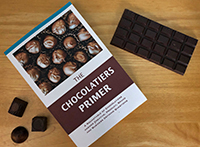“The Chocolatiers Primer” from TCB-Cafe Publishing features almost 20 chocolatiers and chocolate makers (+ 1 blogger) answering a set of questions about their business. It’s designed to give readers real-world advice and insight from entrepreneurs in the chocolate field, hence the word “primer” in the title.
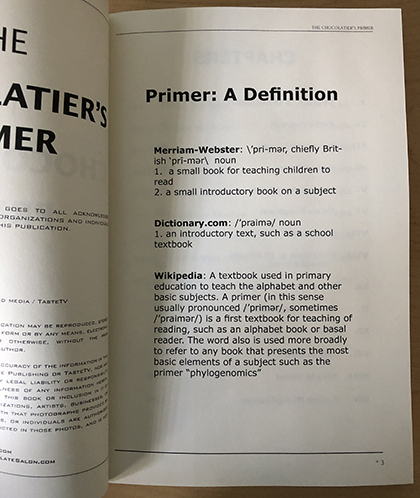
It even includes on the first page of the book several definitions of primer, to help the reader understand the purpose of “The Chocolatiers Primer.” I liked the simple one from Dictionary.com best: “An introductory text, such as a school textbook.”
Not only chocolatiers
While the title mentions “chocolatier” only, the book includes chocolate makers too. This makes for a learning moment, I think, for people who don’t know the difference. Some of the people interviewed explain they are chocolate makers, not chocolatiers, because they work from the bean to create bars vs. chocolatiers who work with couverture to create truffles and other confections.
I think the name was chosen for simplicity’s sake, so just know that this book is not only for people interested in the business of being a chocolatier; it also has a lot of info from chocolate makers, answers from a person who blogs about chocolate from the end user’s standpoint, and some random recipes.
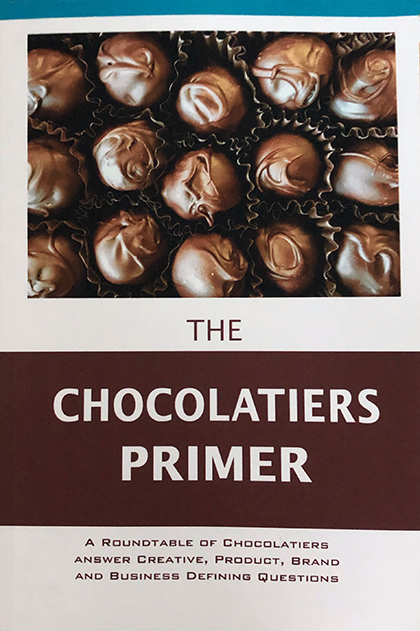

Each person has an average of 10 pages (from a brief 4 pages to a thorough 17 pages) in which they answer the set of approximately 40 chocolate-related questions. Not everyone answers all questions, which accounts for the variation in interview length.
Questions range from Business 101 type questions (about ROI and setting up a business), to chocolate history (both personal and global), to personal likes (favorite chocolate/chocolate maker/chocolate movie/chocolate vacation), to sales & marketing (store vs. online, company name origin, label and logo creation), to creativity (how flavors are developed), and more.
Each person’s section is similar: A front page with the person’s name, basic company info, and a photo. The rest of each section is Q&A with questions in bold, followed by the person’s answer. You can read each section whole, but the format makes it easy to dip in and research a single topic. You can quickly find each chocolatier/chocolate maker’s take on a topic you are interested in by scanning for related questions.
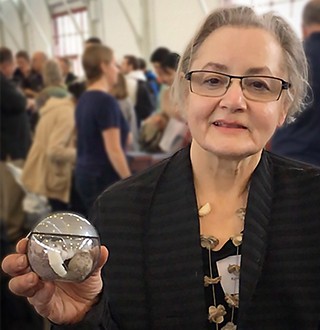

Question meet Answers
Some questions elicited quite a range of answers. For example, “Do you need someone to help you when you develop a new chocolate?” got responses that ranged from ‘nope, it’s all me’ to ‘I ask everyone I know, plus random strangers for input.’ If you are looking for answers, ideas and inspiration for your chocolate business, you will find something to spark your passion here.
While there is a lot of variety in answers, the overall tone is very encouraging, and the thoughtfulness of the answers showcases how open and supportive the chocolate community is. It’s clear everyone interviewed loves chocolate and wants to share their passion and knowledge with others and encourage anyone interested to get into the business.


The breakdown of interviews is 15 chocolatiers, 4 chocolate makers, and 1 blogger. I’m not sure how they decided the order of people in the book; it seems serendipitous to me, starting with SFBA local artisan chocolatier flying noir, followed by 8 other chocolatiers from around the U.S. and Canada. Then it jumps the pond to interview a married couple doing bean to bar in the U.K.
After that long dive into chocolate making (the longest piece in the book), it’s back to North America for 3 more chocolatiers. Next are SFBA bean-to-bar maker Endorfin Foods and SFBA chocolatier The Oakland Chocolate Company. A caramel maker gets slipped in there, before another SFBA chocolatier, Michael’s Chocolates. The primer ends with a Pacific Island chocolate maker, a Hawaiian chocolate maker, and the chocolate blogger.
I was excited to see Michael Benner of Michael’s Chocolates give shoutouts to SFBA chocolate makers, Dandelion and Guittard; honorary SFBA chocolate makers Raphio Chocolate (Fresno), and White Label (Santa Cruz); and SFBA chocolatier Michael Recchiuti. It’s a good example of the strong community feel between chocolate businesses, plus it shows how the Primer can serve as a jumping-off place to explore more about the world of chocolate beyond the people interviewed.
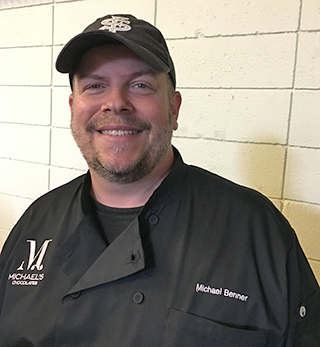

Bread & chocolate
Each person interviewed is interesting, especially if you are already interested in chocolate and wonder how someone can make a living working with chocolate. However, some stories stood out to me, such as Joseph Terpoghossian’s of Mignon Chocolate.
He has a long family history in the food industry, starting with his grandfather’s bakery in Ukraine, which was so successful he ended up getting imprisoned in Siberia by the Communists. From there, the story moved to Iran where he started the business again in 1935 from nothing after getting out of Siberia, and added confections to the breads and pastries they sold. The whole family helped with the business, and in the 60s, they branched out to chocolate making.
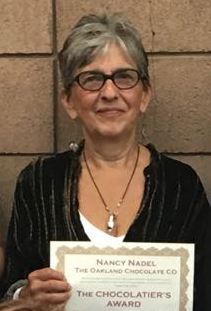

Their cakes and chocolate got so popular in the 70s, that even the Shah of Iran’s family made weekly trips to buy them. Not sure how things went after that, what with the Iranian Revolution in 1979, but the business survived and moved to California. It’s a good read, and Joseph’s sense of humor comes through in his answers.
Ideas & info for non-chocolatiers
Since I am not a chocolatier, nor aspire to be one, I read the primer more for learning about the people interviewed. But some interviews did inspire me, like when the married team of Bob and Iris from Solkiki Chocolatemaker recommended eating chocolate while by the seaside. They said the unending ocean vista combined with the salty air makes it a new experience. I’m definitely going to try that.
They also stumped me with their 4th category of chocolate (not ruby). They said they divide their chocolate into 4 categories: white, milk, dark, and vault. A general Google search revealed nothing about vault chocolate, but on Solkiki’s site they have 2 bars in their Vault section, which as far as I can tell from the packaging are “aged” chocolate. One package lists it as a 2015 Limited Edition. I think they should expand on what they mean by Vault, because if it is that they age some cacao like wine, it sounds interesting.
The tree-to-bar maker Sandrine Wallez of Aelan Chocolate Makers in Vanuatu was another interesting long read. Vanuatu is a country in the South Pacific Ocean that is comprised of about 80 islands. They are growing cacao on some of the islands, and she is working with the cacao farmers to improve their crops and also make chocolate there.
Sandrine describes a lot about the experience, both good and bad, and it’s ultimately a very encouraging story about improving the industry. One thing that struck me was that they have discovered that cacao grown on the different islands vary in taste — it’s micro-origin chocolate, and something they are working to develop.
Reading for the recipes
Finally, in terms of content, I have to mention the recipes. I am not a cook or baker, and have no interest in doing those things even if chocolate is involved. However, I did find the recipes suggested by Karen Neugebauer of Forte Chocolates interesting. They make a line of chocolate for cooking with, and she suggests zesting their lemon & pepper white chocolate bar over salmon or halibut, or making an Alfredo sauce with the bar. I was shocked and intrigued.
A recipe I did not find intriguing however was one by a different chocolatier that included chocolate chip cookie dough. It did shock me though, that an artisan chocolatier would submit a recipe that sounds like a throwback to something in a 1960s food ad in a women’s magazine. But as I said before, answers to the same question cover a wide range in the Primer.
And I wanted to high-five Barbie Van Horn, the chocolate blogger, for her 2-ingredient recipe: She cooks like me! (My ingredient list caps at 3 ingredients. Water counts as one of the 3.) Plus her recipe sounded tasty. She also said she has a special carrying case for chocolate she carries around for sharing and getting feedback on. I think I may need to upgrade from sandwich baggies to appear more professional.
For the second edition
I have 2 quibbles with the Primer: 1. Submissions could use some proofreading and light copy editing. I don’t think comprehension suffers from the typos and minor errors, especially if you already have some familiarity with the topic, but as somebody who makes a living writing and editing, it stuck out to me.
2. I wish there were more photos, especially color pix, and images of company logos and packaging because there are questions and descriptions of them, but no visuals. Luckily, the intro page for each chocolate company lists their URL, so my workaround recommendation is to visit the company site to find relevant visuals while reading for context.
Overall, I found the Primer a very interesting read, and can recommend it to anyone who wants to know more about the chocolate business, or is curious about what kinds of people become chocolatiers/chocolate makers. And if your interest extends to becoming a chocolatier yourself, you can dip your toes in by making some of the recipes first. “The Chocolatiers Primer” is available from Amazon.

